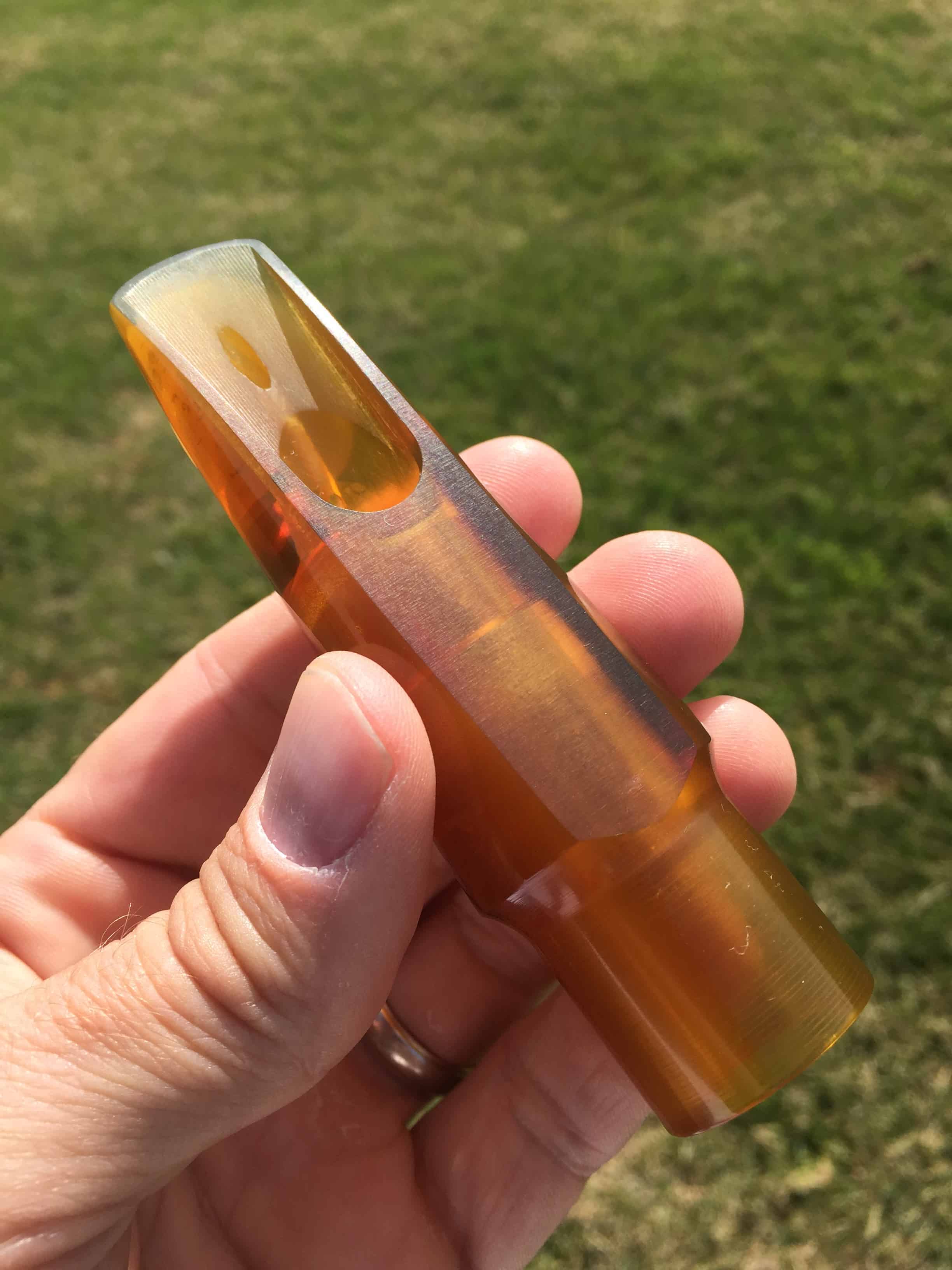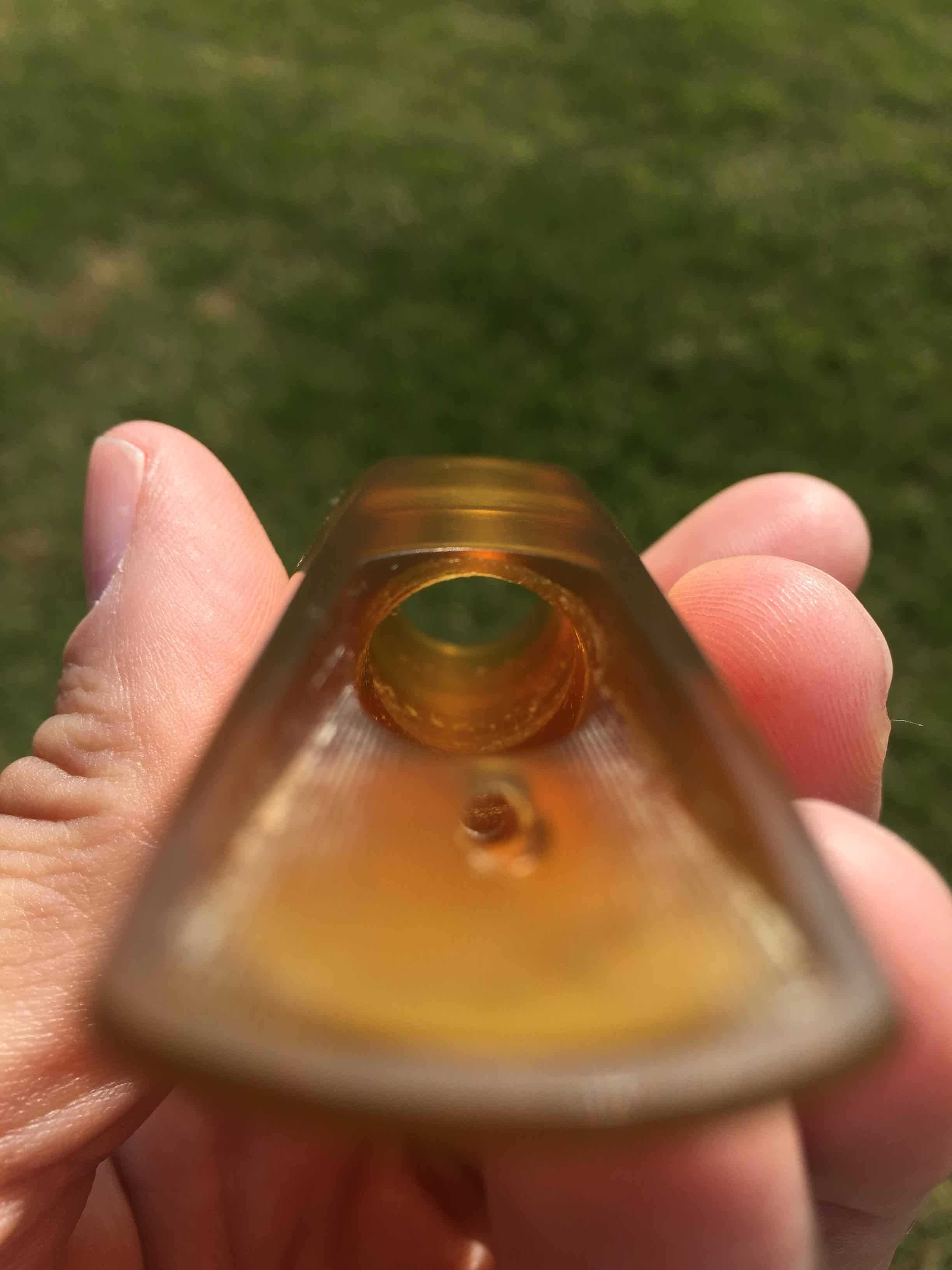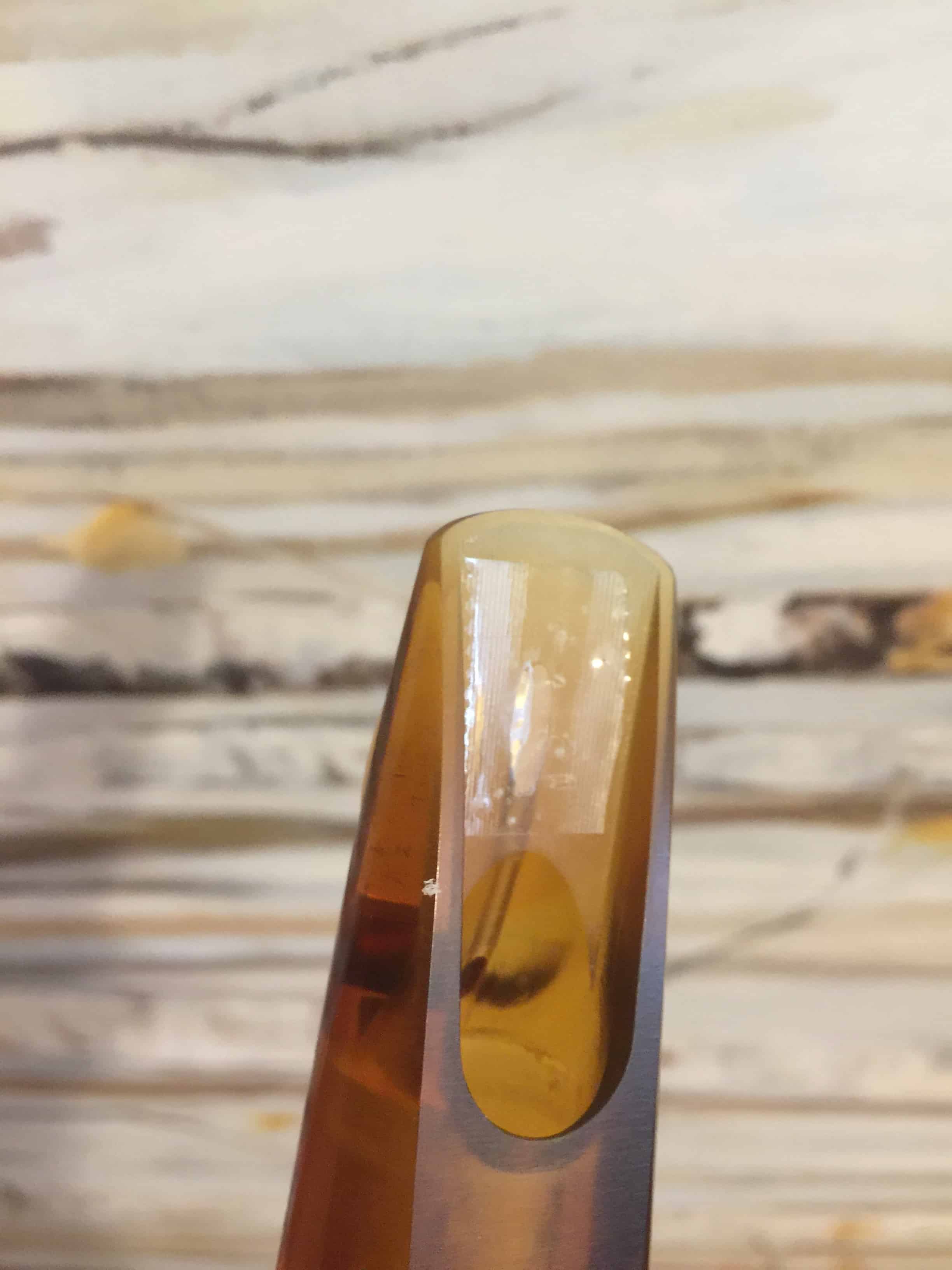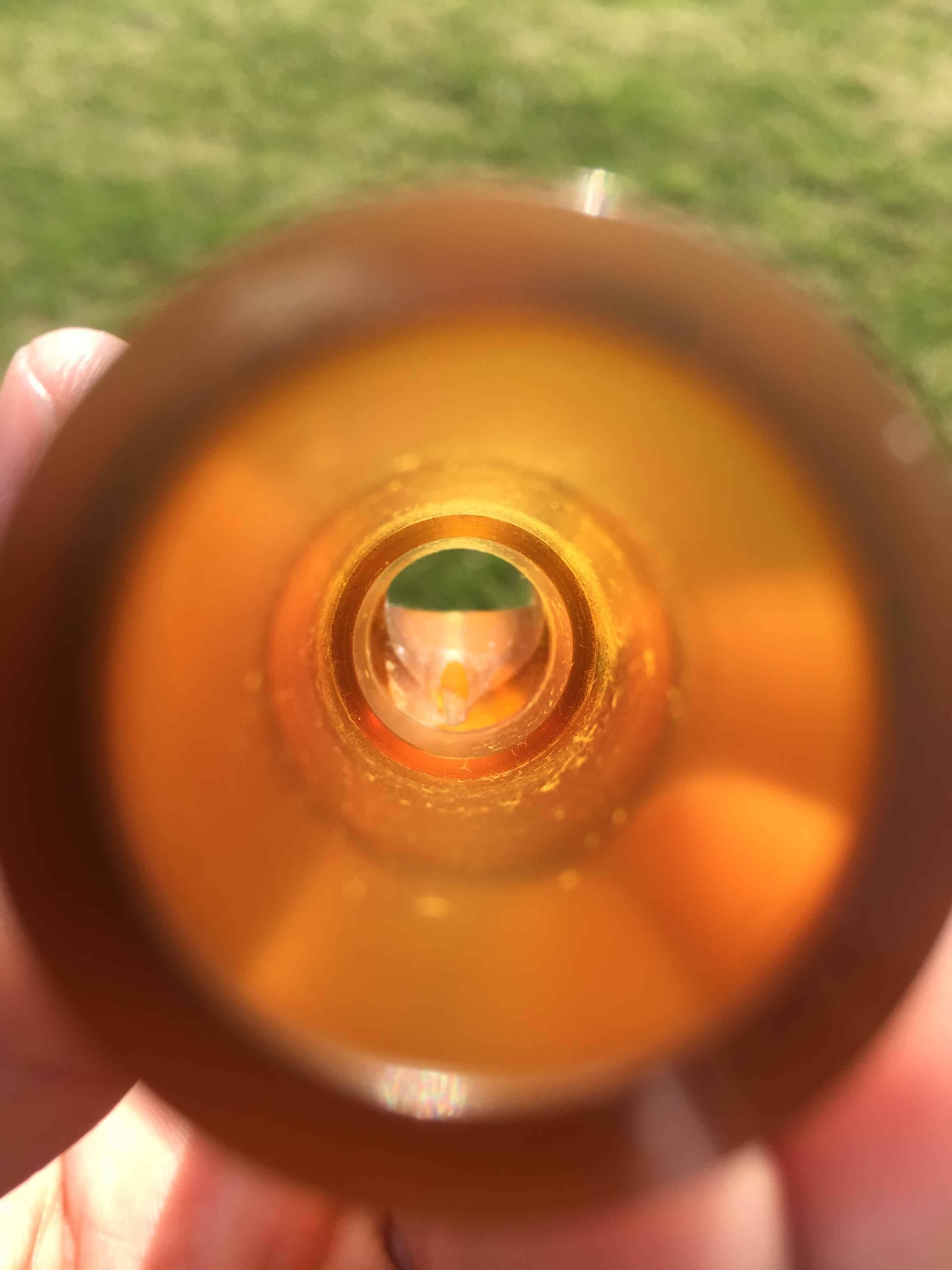Today, I am reviewing an interesting, unique and rare tenor saxophone mouthpiece that I am borrowing from a friend who was close and worked with Ron Coelho. Ron was always experimenting with unique sax mouthpiece designs and “out of the box” thinking in regard to saxophone mouthpieces.
I recently saw a photo on the internet of this RPC Ultem AirBeam tenor sax mouthpiece that I am writing about today. Ron was experimenting with it’s design before his death in 2019 and had mentioned a “super secret” new design he was really excited about to me in our last phone call. When I saw the photo online, I was so curious about it, that I expressed an interest in trying it out. I was contacted by Michael Schuette who was kind enough to let me borrow his RPC Ultem AirBeam tenor mouthpiece for this review.
This is an RPC Gold Series 110B “AirBeam” Ultem tenor saxophone mouthpiece that was made by Ron Coelho, at RPC mouthpieces. Ron called this the “AirBeam” model because of the duct in the baffle that you see in the photos below. The hole starts halfway down the baffle and continues through the baffle until it comes out at the bottom rear of the baffle.
The purpose of this review and blog post is to write about this unique “AirBeam” feature which I have not seen in any other saxophone mouthpieces. If you want to know more about Ultem or more general details about this sax mouthpiece you can see my RPC Gold Series 110B Ultem Tenor Saxophone Mouthpiece Review that I posted in 2019 where I go into more details about Ultem and other details about this model of mouthpiece. Besides the addition of the “AirBeam” feature, this mouthpiece is very similar in design to that already reviewed RPC 110B Ultem tenor saxophone mouthpiece already reviewed.
RPC Gold Series 110B Ultem AirBeam Tenor Saxophone Mouthpiece
I am reviewing and writing about the RPC AirBeam tenor sax mouthpiece more out of curiosity than because of anything else. When I first saw a photo of the baffle of this mouthpiece I was simply curious what this tunnel through the baffle would do to the sound and playability of a sax mouthpiece.
Michael Schuette who was a good friend of Ron Coelho and worked with him posted this on SOTW (Sax on the Web):
“Ron and I were working on the AirBeam baffle, in short, having a tubular duct through the baffle to create some kind of Venturi effect in the chamber and decrease the resistance. There were only a handful of these made, some ended up being paint peelers but the few that actually passed Ron’s quality standards are phenomenal. I have one and putting a piece of scotch tape over the hole really changes the piece pretty dramatically in terms of resistance.”
RPC Gold Series 110B Ultem AirBeam Tenor Saxophone Mouthpiece
I can’t speak to the scientific accuracy of Michael’s description, the venturi effect, or about Ron’s opinions on the matter as he is no longer with us. All I can do is share my thoughts on what I experienced when playing the RPC Ultem AirBeam tenor saxophone mouthpiece in this review.
RPC Gold Series 110B Ultem AirBeam Tenor Saxophone Mouthpiece
I tried a bunch of different reeds on the RPC Ultem AirBeam tenor sax mouthpiece but I found the Lupifaro Evo 2 1/2 reeds (brand new reeds to me that I am trying out) and the Rigotti Gold 2 1/2 Strong reeds to play quite nicely with the RPC Ultem AirBeam tenor sax mouthpiece.
I recorded clips on both of these reeds because I heard enough difference in the tone and response of the mouthpiece that I thought posting clips of both reeds would be interesting. I am not going to talk about the differences in the reeds as this article is specifically on the effect of the AirBeam’s tubular duct. I will let the clips speak for themselves as far as differences between the reeds.
RPC Gold Series 110B Ultem AirBeam Tenor Saxophone Mouthpiece
I posted sound clips of the mouthpiece “as is”, with the tubular duct open as well as clips with the front of the tubular duct taped over with each reed. The reason for this, is so that I could experience and hear the differences in sound and playability when the duct was closed compared to when the duct was open and perhaps capture these differences on the recordings.
RPC Gold Series 110B Ultem AirBeam Tenor Saxophone Mouthpiece
Here are my impressions of the RPC Ultem AirBeam Tenor Saxophone Mouthpiece with the tubular duct open.
I first played the AirBeam mouthpiece “as is” and my initial impressions were that the tone was thick and hearty while having accentuated mids in the tone. Words that came to mind while playing were fat, rich, full and big. The tone reminded me of a bluesy big Texas tenor type saxophone tone with the thickness that comes with that type of sax tone.
It definitely leans to the brighter side of a tenor saxophone sound but the thick and beefy tone made the brightness seem more balanced and not as bright to me.
RPC Gold Series 110B Ultem AirBeam Tenor Saxophone Mouthpiece
The RPC AirBeam could get a surprising amount of volume when pushed. It is one of the louder sax mouthpieces I have played when pushed. I felt like I could push it to 13 on the volume scale. I really couldn’t demonstrate this on the recordings because whenever I tried to push it to super loud it would distort my computer speakers. I think at the most I pushed it to about an 8 on the volume scale during these sound clips.
Contrary to Michael Schuette’s description of the venturi effect earlier in the review, I did feel more resistance in the way the RPC AirBeam blew with the duct open than when the duct was closed later with tape. I wouldn’t say it was a bad resistance but as I will discuss later, I think the resistance made the tone thicker as well as making the altissimo range much easier to play and navigate.
The variation in our descriptions might be due to the fact that the RPC AirBeam mouthpiece with the duct open played much bigger and louder in my opinion. Many times we associate those two descriptive words with “less resistance”. However, when comparing just the blowing resistance between the closed duct and open duct to each other, I am of the opinion that the open duct felt more resistant to me and required slightly more air.
As I have discussed in other threads, I like a certain resistance in a mouthpiece. The resistance gives me something for my air stream to push against and it seems like it makes the tone easier to manipulate, shape and in this case, play louder.
Qualities of RPC Ultem AirBeam Tenor Sax Mouthpiece with Open Duct
- Thicker, More Hearty Tone
- More Volume Without Thinning Out
- Tone More Open, Bigger and More Spread
- More Mids in the Tone
- More Resistance to Push Against
- Low Notes take More Air and Support
- Altissimo Much Easier and Fuller than when Duct Closed
RPC Gold Series 110B Ultem AirBeam Tenor Saxophone Mouthpiece with the tubular duct taped closed
Next, I taped the tubular duct closed and tried the RPC Ultem AirBeam tenor sax mouthpiece again with the same exact reed. With the duct closed, the AirBeam mouthpiece felt immediately less resistant to me. I immediately felt that the mouthpiece blew easier and there was more of a smoothness throughout the range of the horn when playing fast. I can best describe it as a faster response to less air. It felt like the AirBeam with the closed duct would start sounding when my air was at 3% whereas the Airbeam with the open duct would start sounding at 6%. (These numbers are just my subjective guesses of what I experienced and not scientific at all, so take them for what they are worth.)
With the duct taped closed the AirBeam was much more effortless to play softly. It seemed to me that with lesser resistance I could play with very little air and the AirBeam would play at a whisper. With the duct open, the AirBeam still could be played softly but it needed more air and support because of the resistance I was pushing against.
I want to clarify again, that I in no way think this resistance is “bad”. I actually really enjoyed it and think I preferred the AirBeam with the duct open much more because of that thick Texas tenor type of saxophone tone. With the duct closed it seemed like the tone leaned more towards a clean, focused “Brecker” type of tone for me and with it open it seemed to be a bigger, dirtier Texas tenor type saxophone tone. At least those were my impressions.
One statement I can write for sure, is that the RPC AirBeam with the open duct seemed to “wail” much more than when the duct was taped closed. Although the RPC AirBeam with the taped duct played loud, I felt that the open duct allowed the mouthpiece to play much louder and really wail. It felt like the added resistance of the open duct allowed me to push the tone to a 13+ on the volume scale because I had something more substantial to blow my air against.
With the duct closed and less resistance, it felt like the RPC AirBeam maxed out at 10 while I still had more air to push into it. Besides that, it also seemed to me that the more focused core of the tone seemed less complex, more polite and pure when compared to the recordings of the mouthpiece with the duct open. The tone sounded more focused and seemed to have more of a centered tighter core than when the duct was open in my opinion. It also sounded smaller in tone in comparison to when the duct was open. The thicker, bigger tone of the RPC AirBeam with an open duct made it more substantial and fat sounding when pushing it to full volume.
Qualities of RPC Ultem AirBeam Tenor Sax Mouthpiece with Closed Duct
- More Focused, Tighter Core to the Tone
- Smoother Throughout the Range of the Horn when Playing Fast
- Low Notes Required Less Air
- Required Less Air to Play at ppp Softness Level
- Tone More Polite, Pure and Refined Sounding
- More Higher Partials in the Tone (Brighter)
- Not as Rich, Complex and Hearty Sounding. Tone More “Breckerish” than “Texas Tenorish”
RPC Gold Series 110B Ultem AirBeam Tenor Saxophone Mouthpiece
That’s about all I can write in this review about the effects of Ron Coelho’s “duct through the baffle” experiment. I know first hand from talking to Ron that he was very excited about this mouthpiece and design he was working on. In my mind, the duct definitely has an effect on the tone, resistance, response and volume of the mouthpiece. Listen to the sound clips below and see what differences you can hear.
Special thanks again to Michael Schuette who was good friends with Ron Coelho and let me borrow this mouthpiece for this review. Through Michael’s relationship with Ron Coelho, Michael says he learned a ton about working on mouthpieces firsthand from Ron.
If you try an RPC Ultem 110B AirBeam tenor saxophone mouthpiece or have any other saxophone related thoughts or comments, be sure to tell us what you think in the comments below. Like I said above, only a few of these were made so if you get your hands on one you will be one of the few to be able to play one. Steve
RPC Gold Series 110B Ultem AirBeam with Lupifaro Tenor Reeds
RPC Gold Series 110B Ultem AirBeam Tenor Saxophone Mouthpiece with Airbeam Open-Lupifaro Evo 2 1/2 Reed-No Effects
RPC Gold Series 110B Ultem AirBeam Tenor Saxophone Mouthpiece with Airbeam Taped Closed-Lupifaro Evo 2 1/2 Reed-No Effects
RPC Gold Series 110B Ultem Airbeam with Rigotti Gold Tenor Reeds
RPC Gold Series 110B Ultem AirBeam Tenor Saxophone Mouthpiece with Airbeam Open-Rigotti Gold 2 1/2 Strong Reed-No Effects
RPC Gold Series 110B Ultem AirBeam Tenor Saxophone Mouthpiece with Airbeam Taped Closed-Rigotti Gold 2 1/2 Strong Reed-No Effects











Hi Steve,
I knew Ron Coelho very well too and we were friends for years, sometimes talking on the phone for hours. Some six or seven years ago Ron decided to try different materials to make mouthpieces from, other than and in addition to hard rubber. I was the first to beta test the first three he made (for tenor sax): one ultem, one delrin and one radel. After I received the mouthpieces I tested them with various reeds and played each for Ron over the phone. We both agreed the ultem was the way to go, and that’s exactly what he did! I still have that first ultem mouthpiece he ever made, along with a couple of other ultem tenor mouthpieces. Btw, the ultem baritone mouthpieces are fantastic too! Ron did share with me he had a “secret” mouthpiece process he was trying to patent and produce. I told him to keep it a secret, wished him much success with it, and figured I’d find out in the course of time when the “secret” was open. I knew of his health problems, but I didn’t expect him to pass so unexpectedly. I’m grateful that you had the opportunity to audition and review Ron’s latest and last work. Your column is so informative, and your consummate knowledge and experience really helps others to learn about so many great products out there. Thanks so much for all you do and very best wishes!
Geoff Nudell
Steve, thanks for the excellent review and the soundbites. To be honest, I only tried the taped (closed) configuration for a few minutes and then I took off the tape and I just liked it better. I have another 110B that’s almost identical, which is why I never went back, Like you, I found the Rigotti 2 1/2 strong reeds to work very well with this mouthpiece, the other reeds I was using with good success were BSS 2 1/2. I agree 100% on the loudness and maybe that’s where the perceived difference comes from, that is, I could get more volume out of the AirBeam than on its sibling, which can easily be mistaken for less effort to get the same volume, that is, less resistance but those are subjective observations with much less time and effort put into compared to what you did. Either way, the only point is that there is a difference between the open and the closed configuration and it is nicely captured on your clips.
Thank you very much.
I know Ron has a big smile on his spiritual face right now!
Michael
I could be wrong, but the taped mouthpiece seemed better to me all the way around. Faster response and I preferred the tone.
No right or wrong, just about what you prefer……
My preference was duct open. Let the big dog out! But the option is there for two different
sounds. I would like to have one. I dug the Rigotti sound best-but different strokes for different folks. Thanks Steve for doing all these fascinating and thorough reviews!
Try some medium soft baritone saxophone reeds on it and prepare to be blown away. Mine plays way better with bari reeds, but Ron said that was a happy accident. I agree this mouthpiece doesn’t translate well through microphones. I love mine, but you have to commit to it to really get to know all it’s ‘secrets’, IMHO.
How do I order this mouthpiece
Unfortunately, As the review states, Ron Coelho of RPC mouthpieces passed away in December of 2019. Michael Schuette who was a friend and worked with Ron is thinking of continuing the RPC line in honor of Ron but I am not sure how concrete those plans are or the timeline. Steve
Hi Steve,
I agree with what you write about the sound with open or closed duct and I prefer the sound with the open duct. Sound richer.
Giuseppe.
Hi, Steve
I like the open hole because it gives you softer attacks, something that could still control with amount of airsteam that you use in any other mouthpiece. The type of reed and resistant of the reed could make a big difference on the tone.
This mouthpiece is selling for nearly $5000 on eBay!
Did it actually sell for 5000? Or is that just what someone is asking? What someone is asking is very different than what it can sell for…….